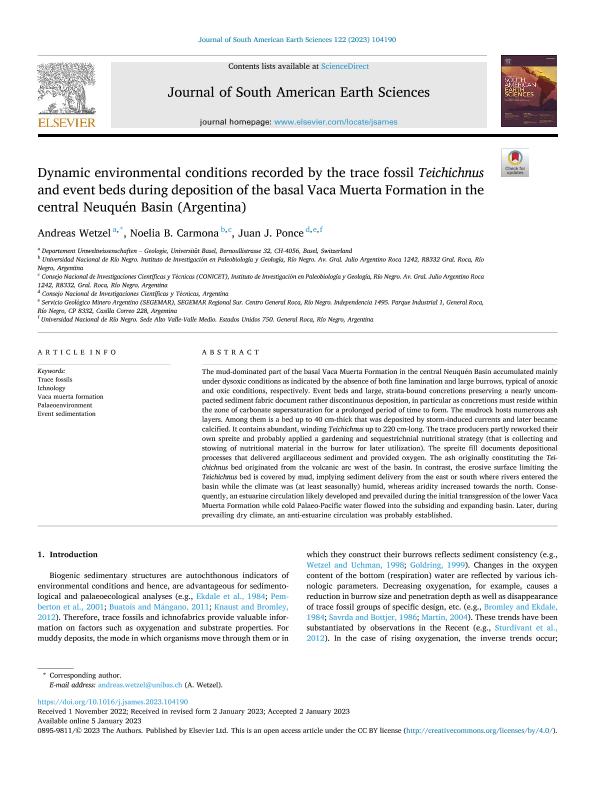Mostrar el registro sencillo del ítem
dc.contributor.author
Wetzel, Andreas
dc.contributor.author
Carmona, Noelia Beatriz

dc.contributor.author
Ponce, Juan Jose

dc.date.available
2024-01-10T13:43:26Z
dc.date.issued
2023-02
dc.identifier.citation
Wetzel, Andreas; Carmona, Noelia Beatriz; Ponce, Juan Jose; Dynamic environmental conditions recorded by the trace fossil Teichichnus and event beds during deposition of the basal Vaca Muerta Formation in the central Neuquén Basin (Argentina); Pergamon-Elsevier Science Ltd; Journal of South American Earth Sciences; 122; 2-2023; 1-17
dc.identifier.issn
0895-9811
dc.identifier.uri
http://hdl.handle.net/11336/223197
dc.description.abstract
The mud-dominated part of the basal Vaca Muerta Formation in the central Neuquén Basin accumulated mainly under dysoxic conditions as indicated by the absence of both fine lamination and large burrows, typical of anoxic and oxic conditions, respectively. Event beds and large, strata-bound concretions preserving a nearly uncompacted sediment fabric document rather discontinuous deposition, in particular as concretions must reside within the zone of carbonate supersaturation for a prolonged period of time to form. The mudrock hosts numerous ash layers. Among them is a bed up to 40 cm-thick that was deposited by storm-induced currents and later became calcified. It contains abundant, winding Teichichnus up to 220 cm-long. The trace producers partly reworked their own spreite and probably applied a gardening and sequestrichnial nutritional strategy (that is collecting and stowing of nutritional material in the burrow for later utilization). The spreite fill documents depositional processes that delivered argillaceous sediment and provided oxygen. The ash originally constituting the Teichichnus bed originated from the volcanic arc west of the basin. In contrast, the erosive surface limiting the Teichichnus bed is covered by mud, implying sediment delivery from the east or south where rivers entered the basin while the climate was (at least seasonally) humid, whereas aridity increased towards the north. Consequently, an estuarine circulation likely developed and prevailed during the initial transgression of the lower Vaca Muerta Formation while cold Palaeo-Pacific water flowed into the subsiding and expanding basin. Later, during prevailing dry climate, an anti-estuarine circulation was probably established.
dc.format
application/pdf
dc.language.iso
eng
dc.publisher
Pergamon-Elsevier Science Ltd

dc.rights
info:eu-repo/semantics/openAccess
dc.rights.uri
https://creativecommons.org/licenses/by/2.5/ar/
dc.subject
EVENT SEDIMENTATION
dc.subject
ICHNOLOGY
dc.subject
PALAEOENVIRONMENT
dc.subject
TRACE FOSSILS
dc.subject
VACA MUERTA FORMATION
dc.subject.classification
Paleontología

dc.subject.classification
Ciencias de la Tierra y relacionadas con el Medio Ambiente

dc.subject.classification
CIENCIAS NATURALES Y EXACTAS

dc.title
Dynamic environmental conditions recorded by the trace fossil Teichichnus and event beds during deposition of the basal Vaca Muerta Formation in the central Neuquén Basin (Argentina)
dc.type
info:eu-repo/semantics/article
dc.type
info:ar-repo/semantics/artículo
dc.type
info:eu-repo/semantics/publishedVersion
dc.date.updated
2024-01-08T14:18:26Z
dc.journal.volume
122
dc.journal.pagination
1-17
dc.journal.pais
Estados Unidos

dc.description.fil
Fil: Wetzel, Andreas. Universitat Basel; Suiza
dc.description.fil
Fil: Carmona, Noelia Beatriz. Consejo Nacional de Investigaciones Científicas y Técnicas. Centro Científico Tecnológico Conicet - Patagonia Norte. Instituto de Investigación en Paleobiología y Geología; Argentina
dc.description.fil
Fil: Ponce, Juan Jose. Secretaría de Industria y Minería. Servicio Geológico Minero Argentino; Argentina. Universidad Nacional de Río Negro. Sede Alto Valle; Argentina. Consejo Nacional de Investigaciones Científicas y Técnicas. Centro Científico Tecnológico Conicet - Patagonia Confluencia; Argentina
dc.journal.title
Journal of South American Earth Sciences

dc.relation.alternativeid
info:eu-repo/semantics/altIdentifier/url/https://www.sciencedirect.com/science/article/pii/S0895981123000019
dc.relation.alternativeid
info:eu-repo/semantics/altIdentifier/doi/http://dx.doi.org/10.1016/j.jsames.2023.104190
Archivos asociados
